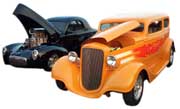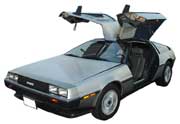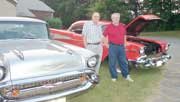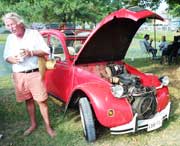|
|
|
 |
|||||
|
Volume 13, Issue 42 ~ October 20 - 26, 2005
|
|||||||
|
We have all seen cars like Phipps’s cruising down Bay Country roads. When the weather is fine, out come the jewels of the highway, the antiques, the street rods, the muscle cars, the luxury imports, old and new … the classics. These beloved vehicles represent, for their owners, a treasure greater than the sum of their parts. Some have said their passion for classic cars has to do with art; others claim it’s about grease. Disagreement among car enthusiasts is not surprising. The culture is as diverse as the cars themselves. When I set out to write this story, I knew almost nothing about classic cars or the culture surrounding them. Like everyone else’s, my neck gets a good workout each summer, craning for a better look at these beauties when one happens to rumble by. In a group, invariably the first person to see the resplendent creature must point it out excitedly to the others: a vision of something extraordinary on an otherwise mundane highway. Classic cars are a reminder that the world is larger in time, place and artistry than our small routines would tell us. I knew this thrill, but not much more. I could not appreciate the difference a model year makes, the quality of a paint job, the meaning of a certain motor. I could not even tell the difference, say, between a street rod and a muscle car, or between a Rolls-Royce and a Bentley. I did not speak this language. And I had no idea there might be a deeper joy beyond spectatorship, the joy of being among the builders, restorers and appraisers of the automotive jewels. Talking to these folks, you might learn a little something, as I did. All the cars we call classic are united by the luster of time upon their surfaces. Yet they fall naturally into different species according to their age, style, and the predilection of their owners. This last is perhaps the most significant determiner. Does the owner wish to restore the car to its original condition, to offer it as a pristine artifact from a departed era? Or is the owner of a mind to create something new? So long as a restored car is at least 25 years old, we can call it antique. Those who step beyond restoration into the world of radical customization give us hybrids of past and present, the phoenixes of the classic car world: the street rods.  Summer Nights Are for Cruising Summer Nights Are for Cruising“A restorer would have passed on my car,” says Mike McDaniel, formerly of Deale, now of Glenwood, as he lounges in the late summer sun beside his black ’35 Ford two-door sedan, a street rod. “Ninety percent of the cars that get turned into street rods would have been passed up by restorers. We resurrect cars that they wouldn’t even look at. They’re too rusted out.” McDaniel drove the car down from Glenwood on a Saturday afternoon to what long-time Calvert countians know as the old Ames parking lot in Prince Frederick. To most everyone else, it’s the lot deep in the back of Calvert Village Shopping Center, in front of Patuxent Imaging and MRI. This is the current home of the Summer Nights Cruisers Car Club, which meets every Saturday evening from May through October. “A lot of people are afraid to drive their cars,” McDaniel remarks. “I feel sorry for them. The fun part is getting in the car and cruising.” McDaniel “builds ’em to drive ’em.” His already 75-year-old Ford gets four or five thousand miles put on it each year on its way to car shows as close as Laurel and Bowie and as far away as Louisville, Kentucky, and Charlotte, North Carolina. Except, well, the only truly 75-year-old parts of the car are the steel body and chassis. McDaniel’s Ford is, after all, a street rod. It is McDaniel — a tall, direct, fair-haired man — who first explains to me the meaning of this term. The car’s headlights, for instance, are from a ’38 Buick. The bumpers and hood are from a ’37 Ford and the grill from a ’36. The gas door is from a ’53 Mercury, and the seats are from a ’60s-era Mustang. The engine, as I was to hear again and again, is all Chevrolet. And the paint job, blue and silver flames on black, is not like anything you would have seen come out of the Ford factory in 1935. In the world of street-rodding, McDaniel says, “There are no rules. It’s about creativity and individuality.” The only parameter is that the car’s body be made prior to 1948. The original cars are then, in McDaniel’s words, “substantially, radically modified” to make the street rod that can be raced or simply enjoyed. McDaniel ought to know. He builds streets rods for a living out of his own shop, J&M Rodworks in Glenwood, and is a member of the National Street Rod Association. He has attended Bay Country car shows for years. Going to the shows, for him, is as indispensable as cruising. “That’s how ideas get spread around,” he says. “That’s how car enthusiasts meet and learn.”
This Saturday, between 20 and 30 cars have gathered in the old Ames lot, a good mix of restored and modified classics spanning 50 years of automotive history. For the first time the club has a DJ, who is spinning songs like “Mustang Sally” and the Eagles’ cover of Tom Waits’ “Ol’ ’55.” Car enthusiasts hover in little groups around particular cars or sit talking off to the side. Curious spectators wander over to the show from other parts of the shopping center. One element everyone agrees is essential to car culture is camaraderie. Classic cars would lose much of their value without car shows, that is, without the chance to see and be seen. Without the shows — the boasts and swagger, the jokes and jeers, the networking and idea-swapping — there would be no car culture. The culture is well-represented around the country by organizations such as the Classic Car Club of America, the National Street Rod Association and the Antique Automobile Club. If you had an interest in classic cars, you could attend the national rallies, contests and tours, learning the various rules and definitions employed by each group. But right here in Bay Country, as in many other parts of the nation, every warm season your neighbors are organizing and attending shows of their own. Some of these shows are for charity, some for promotions. Most are simply for fun and about as informal as you can get, arranged by word of mouth. You may not even know these shows are happening, though you would be welcome if you did. You’d find that the stories, opinions and personalities that abound are often as captivating as the cars themselves. What do you do at a show like Summer Nights Cruisers? You stand around and talk about cars: your car, their car, that magnificent car at the end of the row. That’s pretty much it. No need to be intimidated by the jargon. The conversation gets as in-depth as knowledge and interest allow. Many people don’t know much about drive trains, but a beautiful car is a beautiful car. Just make sure you don’t touch that beautiful car. Fingerprints are no small matter, never mind an accidental scratch.  Dream Cars Dream CarsJim Hitchcock, of St. Leonard, is one of the organizers of Summer Nights Cruisers. He believes he’s seen a resurgence in classic cars over the past 10 years, and he credits it to nostalgia in the aging Baby-Boomer population. “A lot of older guys can finally afford to buy the car they always wanted as a teenager,” says Hitchcock. He himself owns a restored ’57 Chevy and has an old Thunderbird he’s just beginning to fix up. The cream-colored street rod next door, its front end sporting bright orange flames, belongs to his wife. A pair attending the car show at Emmanuel Baptist Church agrees with Hitchcock. Donald Evans, of Huntingtown, isn’t a member of Emmanuel Baptist, but he lives right around the corner. “I came out when I saw the sign,” he says. Evans is the owner of a Roman red ’57 Chevy Bel Air. Beside his car sits another ’57 Bel Air, this one silver. It belongs to his neighbor and friend, Cleo Tolley, who, like Evans, is not a member of the church but simply loves a good show. Evans’s car is “all original, all stock parts,” he says proudly. Having it reupholstered and painted is about all he’s done to it. He wouldn’t dream of modernizing it, even to smooth the ride. “When that car came out, I was 17 years old, and I really wished I could get one. Well, I got one — 48 years later,” he says with a smile. Keeping the car as it is does means putting up with some inconveniences. Evans’s Bel Air has no power steering and only “primitive” air-conditioning. “It feels altogether different” from driving a modern car, he says. When Tolley bought his car, it had already been modified. The Bel Air’s original engine had been replaced with the engine from a ’69 Camero Z28. This doesn’t concern Tolley, as he explains the details of the modification to curious onlookers. The two friends enjoy showing off their cars together, testing their knowledge against that of others, picking up new bits and pieces of information. “We’re just a couple of old guys who get a kick out of having ’em,” says Evans. An elderly man known only as Tex disagrees with Evans about his Chevy. “Of the three Bel Airs, the ’55 is the prettiest,” he drawls in a rich voice. “I’d rather have a ’55 than a ’56 or a ’57. It looks like a little lady.” But Tex, the owner of a completely original ’39 Chevy Master Deluxe, agrees on one point: “When you start changing a car, something is gone of its time.”  Everyman’s Hobby Everyman’s HobbyAs Cleo Tolley’s Bel Air illustrates, street rods aren’t the only modified classics. Some classic cars — perhaps even most of them — fall in between antiques and street-rods. Often enthusiasts use modifications to improve the safety and drivability of an old car, upgrading, for instance, the steering, brakes, transmission and headlights. Others simply want to put their individual mark on a car. In other words, restoration almost always involves some form of modification, but how far this goes depends on the owner. This middle ground between antique and street rod is most common among the class of cars known as muscle cars. Muscle cars, McDaniel informs me, are high-performance automobiles built between roughly 1964 and 1974, or until government regulations and insurance premiums put the brake on their unprecedented power and speed. In McDaniel’s words, they are “small cars with big engines.” Familiar makes and models include the Chevy Camaro, Chevelle and Nova; the Dodge Charger; the Ford Mustang; the Plymouth Barracuda; and the Pontiac GTO. Muscle cars are among the most popular of classic cars, and they often dominate car shows. This makes sense: They are the youngest and hence most available of the classics. These cars are also popular with younger car enthusiasts due to their power and style. They take modern parts more readily than older cars. When restoring a muscle car — a car that was designed to be the fastest on the road — it seems only natural to want to update it to modern standards. To do anything less would be, in a way, dishonoring its calling. With muscle cars in mind, I find myself agreeing with Scott McWilliams, the young general manager of Sneade’s Ace Hardware in Lusby. McWilliams says that the resurgence in classic cars has less to do with nostalgia and more to do with a change in car culture itself. “Ten years ago most owners were guys who had the money to restore the cars, and the cars were garage kept,” McWilliams says. “Now guys are modernizing the cars, driving them on trips, putting mileage on them.” In a world where information and parts are more readily available than ever before, literally at your fingertips on the Internet, the old barriers to expertise are evaporating. Inspired by TV shows like Overhaulin’ and Rides, intrepid amateurs find the parts they need on Ebay and the know-how on message boards. New generations of car enthusiasts, young and old, are turning overhauling into an everyman’s hobby.
The smells of cigar smoke and motor oil mingle in the air. Million-dollar cars have gathered in the garden: Homestead Gardens in Davidsonville, the largest enclosed horticultural center in the Baltimore-Washington metropolitan area. There are Ferraris, Austin-Henleys, Packards, Corvettes, Cobras, Maseratis and Bentleys. There are also a few street rods, a row of Ford Edsel Rangers and a Plymouth station wagon with a wooden cab, an old woodie wagon. But above all, there are Rolls-Royces. Perhaps 40 of them. They are all stunning, but one in particular catches my eye. With its open cab, its white-trimmed tires, its lustrous red body and its external trunk (literally a glossy black trunk mounted above the car’s rear bumper), it is as handsome a car as could be. The black roof covering the back portion of the cab looks like a shiny top hat. I have heard people exclaiming over Kier Boyd’s 1931 Rolls-Royce Phantom II all afternoon, but the owner, from just three miles down the road, sits by himself under the shade of a large tree. There is an unconfirmed rumor that his car was deemed “flawless” by the Rolls-Royce company, quite a rare designation, but when I try to fish the truth out of him, Boyd does not bite. This editor of a Phantom II newsletter won the Homestead Gardens contest last year, so this year he took his car out of the running. Time to sit back and relax. “The mystique of Rolls-Royce captured my imagination,” he says. Boyd’s Phantom II is among the oldest cars at the show, where the 1980s’ line is well-represented. “I like the pre-war cars better,” Boyd allows. “After the war, all the Rolls-Royces begin to look the same.” Before World War II, the Rolls-Royce company built only a car’s chassis prior to a sale. If you wanted to buy one, you’d sit down with a designer and have the rest of the car custom-built. This makes every pre-war car unique. “If you’ve seen one Silver Shadow, you’ve seen them all,” Boyd proclaims of the later models. In the antique car world, the terms concourse and touring are used to classify cars according to whether or not they have been modified. Of course, the only modification allowed in most antique car circles is what is necessary to make the car safely drivable. A concourse car, Boyd explains, has been left in its original factory condition. This usually means it cannot be driven and gets a lift to shows on a trailer. A touring car, on the other hand, has had its workings modernized to the extent that the car can be driven — even cross-country. Boyd drove his car to Homestead Gardens. In the process of restoring his Phantom II, he had the body taken off and the chassis rebuilt. He added power-steering, overdrive, modern oil filters and spark plugs. Then the car was sent to Ohio for professional cosmetic work. The car’s brakes and transmission remain archaic. Have you ever seen a transmission without a clutch? I couldn’t guess how to work it. A poster depicting the 13-part procedure for starting the engine left me daunted, full as it was of references to strange levers and gauges and pressures. Such things are, for Boyd, the definition of fun. In The Garden of Rolls-Royce and Bentley Cars like Boyd’s are generally not for the everyman. Most of the car owners at the Homestead Gardens show are, as Gardens’ marketing director Tim Hamilton put it, “men of means”: doctors, lawyers, professionals. Their cars are valued not simply for their age and style but for their monetary value and social prestige. This may explain why more recent models from the ’80s and ’90s joined the more classic cars at this show. It might take wealth to own a luxury car, but anyone can see why the cars are prized. They are magnificent in their almost architectural beauty, their fine paint and upholstery and their stately elegance. We can be glad that someone is taking care of them. Anchoring the Homestead Gardens show is the Chesapeake Chapter of the national Rolls-Royce Owners’ Club. The club started meeting at Homestead four years ago, and the event quickly grew. The Rolls-Royce group typically invites other clubs — such as, this year, a club of Ferrari owners — but Rolls-Royce continues to dominate the show. Anyone can bring a classic car of any type to the event, but only Rolls-Royces and Bentleys are judged in the contest. If you’ve ever had trouble telling a Rolls-Royce from a Bentley, there is good reason: the two were originally made by the same company. Bentleys are Rolls-Royces with “a few less goodies,” explains Peter Newton, of Davidsonville, who sits on the board of directors of the national Rolls-Royce Owners’ Club. This is less true today, now that Rolls-Royce and Bentley have been split up between Volkwagen and BMW. But for older models, the only noticeable difference between the two is their grills. “If I put a Bentley grill on a Rolls, you’d think the Rolls was a Bentley,” Newton says. A new Rolls-Royce Phantom will set you back at least $375,000. New Bentleys start at $175,000. Some of the older, rarer Rolls-Royce models run from $200,000 to $300,000 up to millions of dollars. Newton gives a sort of pedigree of his two ’86 Rolls-Royces, recalling the places in England where the cars were built and assembled. Hamilton notes that most of the cars have stories behind them, stories that bring the cars to life. “The cars are just a conversation piece,” he says. It is the narratives behind them that really matter, giving this community its substance and momentum. The oft-told car story at this year’s Homestead Gardens show is of Lucille Ball’s favorite car, a 1965 Rolls-Royce Silver Cloud III Drophead Coupe. Lucy bought the car from Debbie Reynolds not too long after Reynolds had purchased it. Now a man from Potomac shows it off in the Homestead Gardens parking lot.  Moving Sculpture Moving SculptureOf course, it isn’t just luxury cars that have stories behind them. And it isn’t just wealthy men who wish to preserve the historical integrity of classic cars. Stacey Hann-Ruff is the director of Annmarie Gardens. She had a hand in running the Gardens’ first Antique and Classic Car Meet this past June. Due to space limitations, the event was only open to antique cars, not street rods or other modified vehicles. Hann-Ruff knows something about the antique-enthusiast’s mentality. She compares them to Civil War reenactors. “These guys can be real sticklers when it comes to whether a part is authentic,” she says. “They’re so dedicated to what they do, you’ve got to respect that.” The cars looked right at home in the sculpture garden. “The cars aren’t just sitting by themselves. They reflect the culture — the architecture and fashion — of the time,” she says. “They are absolutely works of art.” Back at the Deale Bluegrass Festival and Car Show, where the mascot is a banjo-picking crab in a speeding street rod, I have parked my silver 1999 Honda Civic EX among the big boats at Herrington Harbour. I find it difficult to believe that my ho-hum car might one day, by virtue of its age, be a classic. Classic cars — the real thing — are arrayed both inside and outside the gates, so many are there. It’s a good mix: street rods, muscle cars, trucks and restored antiques. There are even a few unrestored cars — cars pretty much just as time and use have left them since they emerged from the factory 40 to 60 years ago. One such car is Goldwin Smith’s 1966 Citroën 2CV Ugly Duck from France. There isn’t really, of course, any such model as the Ugly Duck. But this is exactly what you might think it should be called, seeing the small, red and faded beetle-esque oddity among so many bigger, burlier machines. Smith keeps his long white hair pulled back in a ponytail. He has a keen and whimsical sense of humor and a relaxed air. While others at the show bragged about their cars going from zero to 60 in three seconds, Smith proudly shared the Ugly Duck’s accomplishment of zero to 60 in 35 seconds. Pretty good for a 40-year-old, two-cylinder, 30-horsepower engine. Besides, he says, with his car, you get “more smiles per mile,” not to mention more miles per gallon of gas: up to 54. Smith is from Detroit, that ancestral home of so many cars, where in 1956 he got into drag-racing. How this influenced his purchase of the quirky French Citroën is unclear. It did instill in him a love of automobiles and of “the romance of the road.” “A car is a moving sculpture, an art form,” Smith says. Smith and his wife fell in love with the Citroën 2CV on a trip to France. When they returned, Smith kept his eye out, and eventually he found one for sale in Alexandria. He bought it for his daughter on her 16th birthday. Luckily for Smith, his daughter fell for the Ugly Duck, too. The car’s reupholstered seats now sport images of tiny sailboats, life preservers and ship’s wheels. This summer, Smith’s daughter drove off in the car to attend college in New York City. He retrieved the Citroën for the Deale Show. He likes to speak of the car’s less obvious merits, particularly its extremely soft suspension. It was designed, he claims, so it could be driven across a field at 30 mph without spilling a glass of wine held in the hand of the driver. I give him a quizzical look. “It was intended to be a replacement for a French peasant’s horse,” Smith explains. “And its slim tires, high clearance and ultralight weight make it great off-road. The French military even used these cars in their desert campaigns.” Other than the upholstery and new tires, the car shows its age. Smith is philosophical on the question of restoration. “It’s like being young or being old: Which gives you more pleasure?” He pauses briefly before answering his own enigmatic question. “I like cars that have developed the patina of an old bronze statue.”
|
|||||||
|
|
|||||||
|
© COPYRIGHT 2004 by New Bay Enterprises, Inc. All rights reserved. |
 Cruising with Classic Cars
Cruising with Classic Cars


 About the Author
About the Author